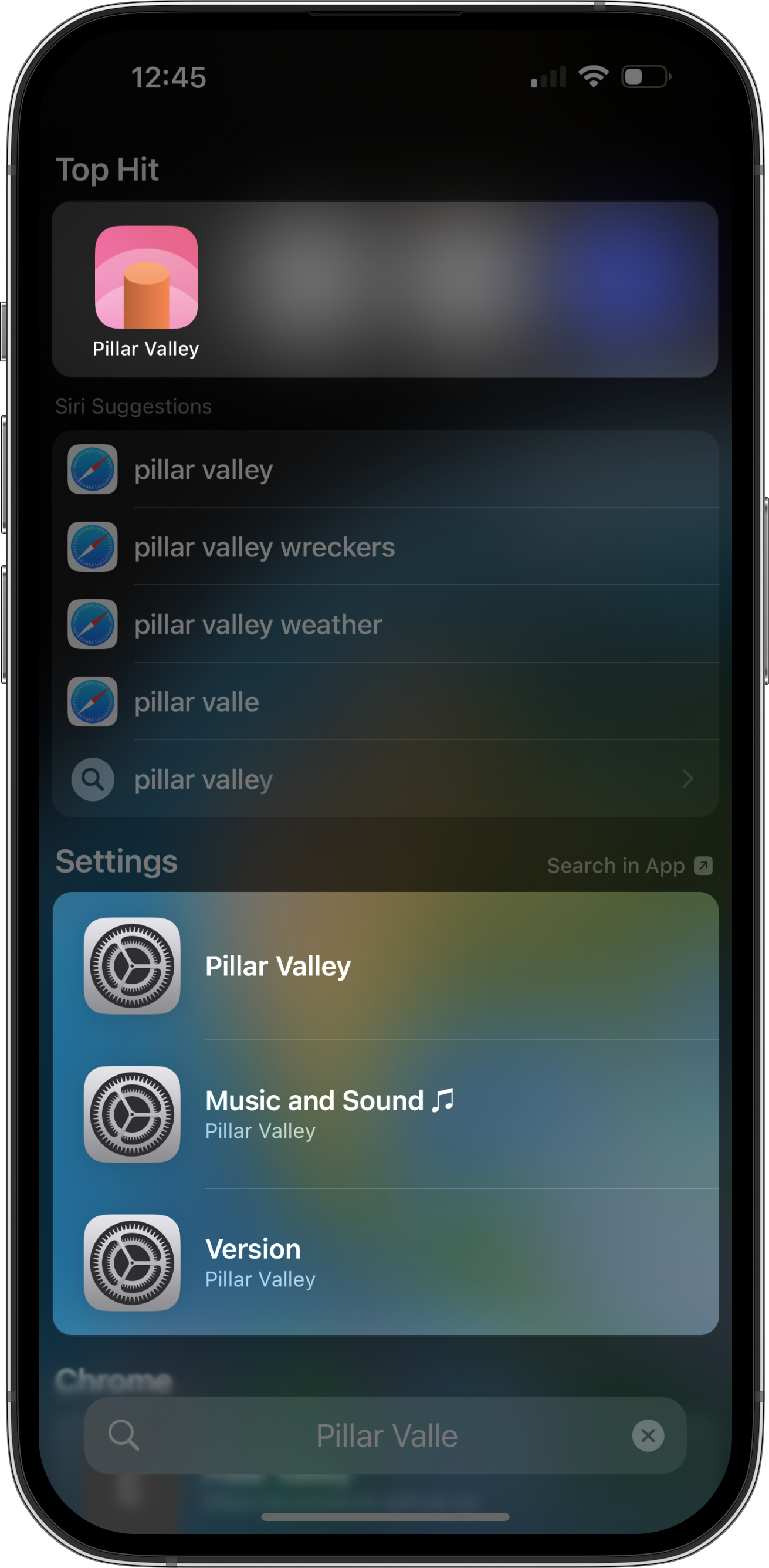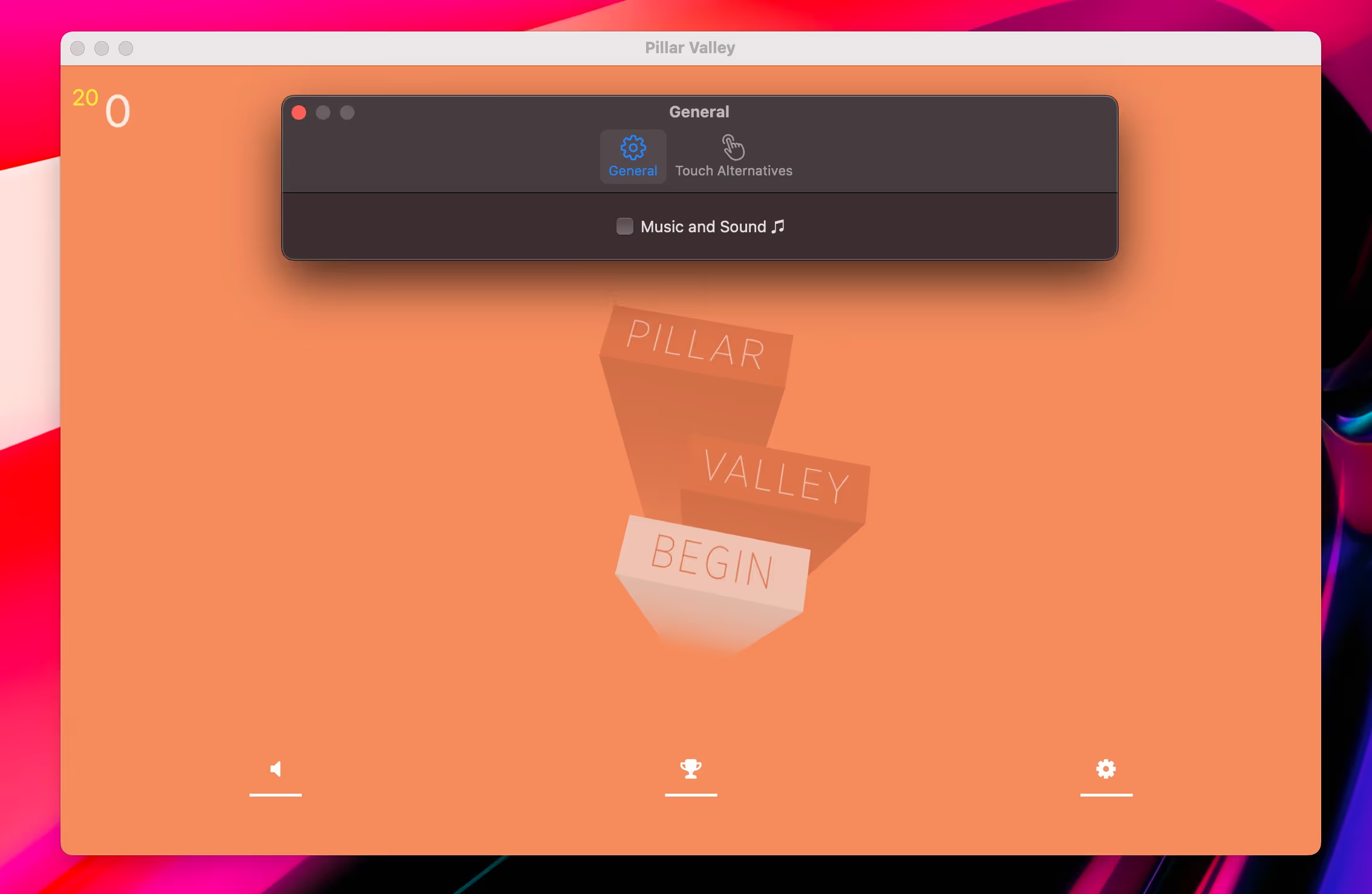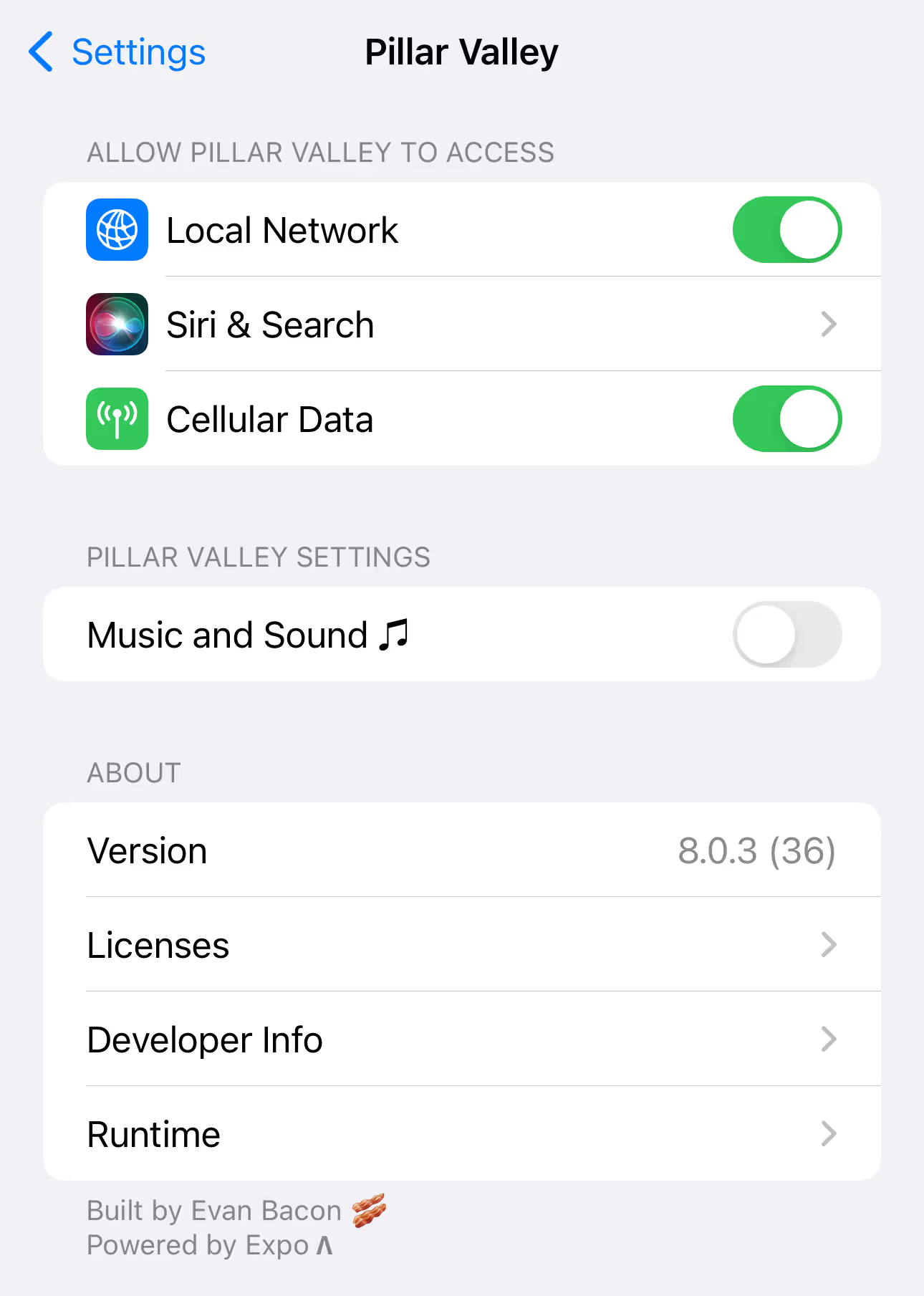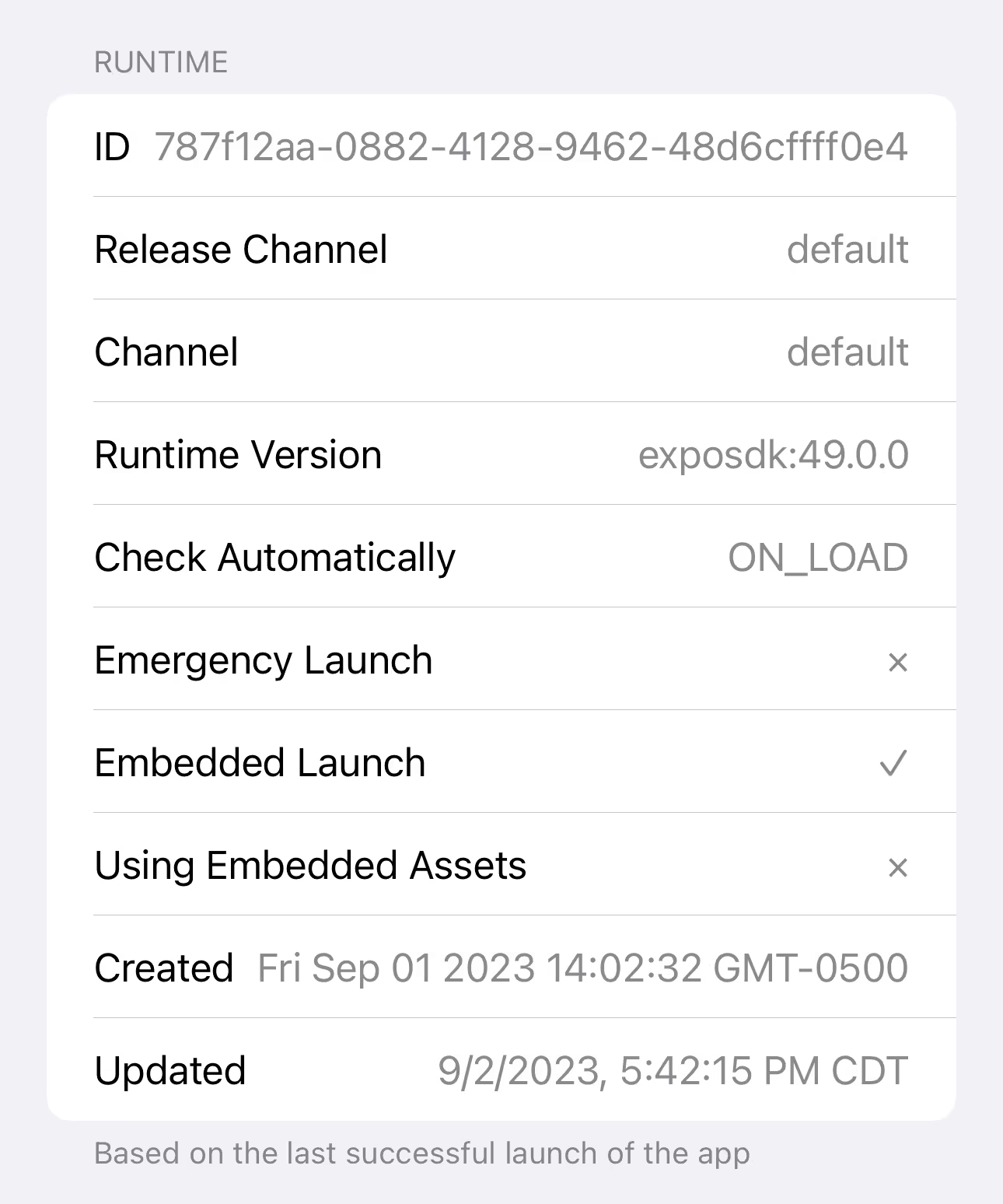Custom Apple Settings UI with Expo
August 22, 2023
Generating an iOS Settings Bundle and sharing settings with your Expo app.
As someone who's constantly in the pursuit of making the most native possible user experience, I often find myself working with pretty obscure native APIs. Today, I'll be sharing my experience of adding custom native UI to my Apple app's page in the native Settings app.
Before we begin, I'll be the first to say that unless you're building the Blackbox app, custom Apple Settings UI should probably not be a release-blocking feature for your app. The usefulness is questionable, and the value is fleeting. However, if you over-index on native app quality, then this post is for you.
Features
Outside of the obvious, having your app's settings in the native settings app, there are a few other neat features that come with implementing Settings.bundle.
Spotlight Search
Auxillary pages and controls for your app show up in the native Spotlight search. This helps users find the settings they're looking for.

Desktop Support
If your iOS app is available in the Mac App Store, then your settings will also be available in the native settings for the app when you press ⌘ + ,.

The Goal
Many years ago, I built a small video game, Pillar Valley, that I now pump full of whatever native functionality I stumble across. It has haptics, native navigation controllers, full universal linking, quick notes, Apple Handoff, password sharing, custom app icons, runs on iOS, Android and web, and is optimized for start-up by using Hermes (no JavaScript runs on-device on native platforms). All the features you expect when downloading a single-tap video game from the store.
As you can imagine, when I learned I could duplicate the in-app settings page in the native system settings, I leaped at the opportunity.
The goal was to add the following pages to the system settings:
- The app version and build number.
- Some shared interactive setting. I landed on a switch for toggling the in-app audio.
- A custom page with third-party licenses and attribution. Sometimes these show up in the setting search and I thought it'd be cool if I saw some of my friends pop up in there from time to time.
- Finally, I wanted a page with preset fields that would be updated on app-launch. I planned to use this page to display remote config info for the particular launch of the app.

Implementation
Adding the settings is a process that involves using some obscure plists in a particular order, then linking those plists with strings files for localization. Some values are localizable, others aren't. Finally, building the app a bunch of times to validate the "types".
There are three core concepts involved:
- Plist files (xml) in a Settings.bundle (special directory). There must be a Settings.bundle/Root.plist which defines the content that shows in the main app settings page. Root.plist can link to other plist files.
- Strings files for localization. You can add a strings file for any of Apple's supported languages (cite needed, not interested in finding), and define a key/value pair for an ID that maps to a display value, e.g. welcome = Bon Jour!.
- NSUserDefaults for reading and writing data at runtime. This is an API that serves many purposes. It can persist data between runs, share data between apps in an app group, and apparently read/write native settings.
One unique attribute that all three of these APIs share is that I hate using them. Plist files are just overcomplicated JSON files, strings are just overcomplicated JSON, NSUserDefaults is fine but the API does have a lot of weird caveats to support all the various use-cases that it serves, e.g. defaults are inconsistent, caching is complicated and under-documented, etc.
Not to mention, these are all unique to the various other aspects of my app. Ultimately, introducing a bunch of unique systems will make upgrading harder and the project more difficult to maintain. If you contrast this complexity with the user value that it adds and divide that by the amount of attention I want to give the project, it's a no deal.
So the challenge here is to reduce the cognitive overhead such that the amount of value users get (near none) is roughly equal to the amount of time it takes for a developer to implement. Additionally, I want a page for third-party licenses that would need to be manually updated/unified every time I update, add, or remove a library––sounds like a nightmare.
This is where Expo Config Plugins really shine.
Why do in one hour what you could do in twelve.— My subconscious —
Enter Expo
With an Expo Config Plugin, I could generate the plist and strings files with TypeScript. I could also add full autocomplete for every aspect of the feature, this would reduce the time-to-failure drastically by moving the validation from an Xcode build (infinity time) to a TypeScript validation error (milliseconds).
I could also remodel the API to match the native API. Since I'd be working with React Native, I could add models that matched the React Native code. For example, a setting the value in <Switch /> would be DefaultValue in Settings.bundle, and value in React Native, we could use Config Plugins to unify these, further reducing the cognitive overhead.
Finally, we could use the npx expo prebuild step to generate complex pages at build-time, this would prove useful for the licenses page which could potentially have hundreds of values.
Config Plugin API
Unlike typical Expo Config Plugins, which are often used via JSON, this one would be a TypeScript-first plugin that would use data models that you'd import from the config plugin.
app.config.ts
import withAppleSettings, {ChildPane,Group,Switch,Title,} from '@config-plugins/apple-settings';module.exports = ({ config }) => {return withAppleSettings(config, {// The name of the .plist file to generate. Root is the default and must be provided.Root: {// The page object is required. It will be used to generate the .plist file.// The contents will be converted directly to plist.page: {// The `PreferenceSpecifiers` defines the UI elements to generate.PreferenceSpecifiers: [// Child panes can be used to create nested pages.Switch({title: 'Music and Sound ♫',// The NSUserDefaults ID.key: 'p_inapp_audio',value: true,}),],},},});};
Each model Title, Switch, Slider, etc. would work like a React view. I considered implementing a custom React reconciler for this but ultimately decided against it since it would introduce a lot of unavailable API like children, e.g.
// Alternative React API:export default function Root() {return (<Page><Switch>{/* This wouldn't be allowed, and the error would come much later. Decreasing iteration speed. */}<div /></Switch></Page>);}
Could you imagine if I actually shipped this though, haha.
Type Safety
Unlike most of Apple's configuration-based feature, Settings.bundle is actually suprisingly really well typed/documented. The first thing I did was create a JSON schema then I generated TypeScript types based on the JSON schema, this ensured I could extract as much validation as possible out of Xcode and into the "user"-space.
Terminal
# TypeScript generation command𝝠 npx json2ts -i ./schema.json -o ./src/schema.d.ts --additionalProperties=false --unknownAny=false
With this, we had perfect autocomplete for every field, and full static validation + standardized errors across the entire system.
Data Sharing
In React Native, this is pretty straightforward as NSUserDefaults is already exposed via the Settings module.
import { Settings } from 'react-native';// Reads from the Settings.bundleconst switchValue = Boolean(Settings.get('p_inapp_audio'));
I paired this with Zustand using "zustand/middleware" to sync the in-app toggle with the system settings toggle.
For the more static data, I added a hook that runs at startup in the application to sync info to the system settings. This is where I'd add the remote config info.
import * as Updates from 'expo-updates';import { Settings } from 'react-native';function displayDate() {return new Date().toLocaleString('en-US', {timeZoneName: 'short',});}export function useUpdatedUpdatesInfoInSettings() {Updates.useUpdateEvents(event => {Settings.set({p_exupdates_live_type: event.type,p_exupdates_live_message: event.message ?? '',p_exupdates_live__updatedAt: displayDate(),});});}
As a result, we can now see startup info in the system settings.

Licenses page
To generate the licenses page, we generate a JSON file with all the third-party licenses data:
Terminal
# Licenses generation command𝝠 npx npm-license-crawler --onlyDirectDependencies --dependencies --json src/constants/Licenses.json
Then I used the the config plugin to create a licenses page with the third-party licenses JSON:
app.config.ts
import withAppleSettings, {ChildPane,Group,Title,} from '@config-plugins/apple-settings';module.exports = ({ config }) => {return withAppleSettings(config, {Root: {page: {PreferenceSpecifiers: [// Add a link to a `Licenses` page.ChildPane({title: 'Licenses',// Link to the `Settings.bundle/Licenses.plist` file.file: 'Licenses',}),],},},// This will generate a `Settings.bundle/Licenses.plist`.Licenses: {page: {PreferenceSpecifiers: [Group({// This text shows up on top of the group.title: 'Licenses',// This text shows at the bottom.footerText: 'Welcome to the bottom of the licenses page, silly.',}),...Object.entries(require('./src/constants/Licenses.json') as Record<string, any>).map(([name, info], index) =>// Add an entry for each license.Title({// Name of library.title: name,key: 'license_' + index,// Type of license.value: info.licenses,})),],},},});};
Now we can generate a ton of XML data at build-time, and we can also use TypeScript to validate the data.

Conclusion
We now have a fully-typed, and script-able system to generate complex native settings pages with ease, entirely with clean-up built-in so I can remove it in the future if I ever come to my senses.
Now my app feels just a little bit more native and I didn't have to compromise on upgradability or maintainability.
- Example: Settings plugin in Pillar Valley.
- Download Pillar Valley in the iOS App Store to see the settings in action.
Thanks for reading 👏
- Join the Discord server to discuss more.
- Help me out by starring ⭐️ Expo on GitHub.